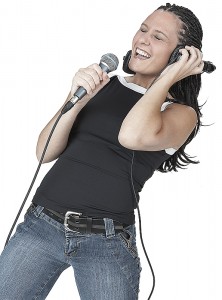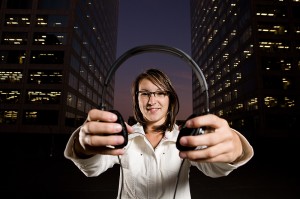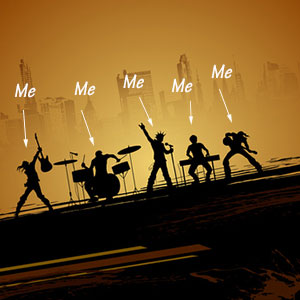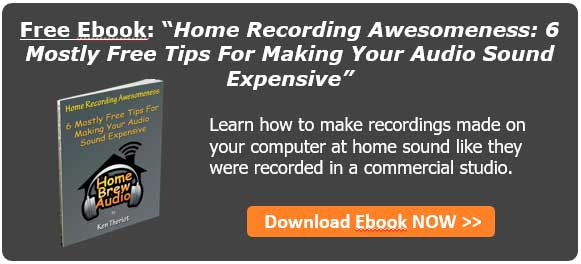With today’s PC audio recording technology, it easier and cheaper than ever to put out a CD.  Are you listening to this all you money-challenged songwriters and performers? Excuses are over. Here is a quick guide to get you your own CD fast.
Are you listening to this all you money-challenged songwriters and performers? Excuses are over. Here is a quick guide to get you your own CD fast.
First you need a list of songs to put on the CD (assuming it’s a music CD). Things will go a lot smoother if these are songs you have written, otherwise own the copyright to, or are public domain. Then you need to actually record those songs. That last bit is where most people get hung up;). Let’s just set your mind at ease, shall we? If you have a computer with a sound card and a microphone, you can make multi-track recordings starting today, without spending a dime on gear or studio time. Just download the open source audio software called Audacity, and you are ready to rock.
If you need to buy a mic, you can actually get this done with a cheap plastic PC mic for about $5.00. But if you can afford to spend at least $49 on a USB microphone, that will be a quantum leap in sound quality. Now just open up Audacity (or whatever audio recording program you might have). For simplicity’s sake, let’s pretend your example song has two guitars, a tin whistle, and three voices singing 3-part harmony.
The first thing to do is to “lay down” your first track. Set up the mic, press the “record” button in the software, and have your rhythm guitar player play the song all the way through. That’s track 1. Now have the lead singer sing along with the guitar track that was already recorded. For this, the singer will have to listen to the playback of the guitar through headphones. You don’t want to record the speakers. Everyone should be on their own track. Then follow suit with the other singers, the second guitar player and the tin whistle. Now your song is recorded on six tracks in the software.
Time to mix! Adjust the volumes of all the tracks so they blend correctly. Then pan one guitar to the left side (sound will come out of the left speaker more than the right), and the other guitar to the right. Keep the lead vocal in the center, and pan the harmonies one left and one right. When the song sounds good, “mix it down” by exporting it as a stereo wave file. Now do the same thing with all your songs.
Once you have all the songs recorded, decide which order they will play in on the album, and burn them to a CD-R in that order. Now all you need is the artwork for the CD insert and label. No problem, there are lots of graphics programs out there to help, some for free like Audacity. Design 4 graphics files, a label for the CD itself, one for the cover, one for the back of the cover, which will be visible on the left when the CD is open, and one for the tray card. Most graphics programs have templates for these.
Now you have a choice. You can manufacture these one-by-one, which I recommend you do at first, but getting empty CD jewel cases and printable CD inserts at an office supplies store. Print your inserts and labels. Peel and stick your labels on your blank CDs, stuff the jewel cases with the inserts, plop the CD inside, and your done. You could also but them into CD-sized jewel bags (a few pennies apiece) for protection and a bit more of a professional look.
Make 10 or 20 copies, take them to your gigs with you and you’re done! Just don’t forget to tell your audience that you have CDs for sale at your show. In the next article I’ll talk about how to go “global” with your CD. If you want to learn more about the recording process, visit the Home Brew Audio website and start make your first recording in the next hour. Now go to it…no more excuses!
good recordings on a budget
Home Recording Equipment for Your Starter Studio
 I’m going to suggest a few pieces of home recording equipment for you to start a studio at home. But unlike a lot of other articles out there doing the same thing, I’m going to get you going (more than 90 percent of you any way) for well under $10. I’m taking it as a given if you’re reading this (that’s the 90 percent part) that you have a computer with a sound card and an internet connection. The only thing I’ll assume you need is a microphone of some kind. But you might be surprised at my recommendations on that score.
I’m going to suggest a few pieces of home recording equipment for you to start a studio at home. But unlike a lot of other articles out there doing the same thing, I’m going to get you going (more than 90 percent of you any way) for well under $10. I’m taking it as a given if you’re reading this (that’s the 90 percent part) that you have a computer with a sound card and an internet connection. The only thing I’ll assume you need is a microphone of some kind. But you might be surprised at my recommendations on that score.
The first thing you’re going to need to do with a new home recording studio is learn how to use it. And guess what? You can learn to do all audio recording basics with a $5.00 PC microphone. In fact, depending on what you will be using your studio for (voiceover only, for example), the audio quality you get from your “training” studio may be sufficient. It’s mostly about technique than gear, and by using the right techniques, even with the cheapest gear, can yield some very surprising audio quality.
Your actual recorder will be a piece of software that is amazingly powerful for the price….which is “free.” That’s right. A program called “Audacity” is available for download from the web. It’s open-source and well-nigh ubiquitous now. So there is lots of support and information for it.
If your plan is to record music, you probably won’t be satisfied with the quality of a PC mic into a factory sound card. So does that mean you have to move immediately to an expensive mic costing hundreds of dollars? Absolutely not. In fact, there is a massive quality improvement in sound quality just by springing for a USB microphone like the Samson Q1U USB mic for just around $49. I’d bet that a vast majority of folks starting their first home recording studio would need nothing more than this to create and produce professional quality audio.
So did you think you could get all the home recording equipment needed for a studio for only $30.00? It’s true. Combined with the video tutorials at Home Brew Audio, you have no more excuses for not creating and producing your own pro audio from home.
Click here if you’d like to get started right away.
How to Record Yourself As a One-Person Band on a $5 Budget
 Do you play several instruments? Can you sing harmony? Would you like to record yourself doing all those things at the same time? Are you broke?
Do you play several instruments? Can you sing harmony? Would you like to record yourself doing all those things at the same time? Are you broke?If you answered yes to all the above, there may be some very good news for you. I know a way you can record yourself doing one thing, then record yourself doing something else along with that first thing. This used to be called “sound-on-sound” recording. More often these days, it is called “over-dubbing.” All you need to over-dub several tracks of audio is a computer with a sound card, and a microphone to plug into the computer. Even one of those cheapo $5.00 plastic PC mics will get you started. Would you not agree that a LOT of folks have that stuff already? Or they could have it after a quick trip to the local office-supply store (for the mic). Once you have all that stuff, all you need to do is download an open-source audio program called Audacity from the internet, and install it on your computer. You now have a home recording studio!
So how do you do the one-person-band thing? Let’s imagine you play guitar and sing. First, you would plug the mic into the pink jack of the sound card. Then open Audacity. Click the button in the tool bar that looks like a big red dot, which means “record.” Your studio will now be recording. Play the guitar part to a song you know…JUST the guitar part; no singing just yet.
Once you finish the guitar part, you’ll need to stop recording (click the “stop” button, which looks like a big square in the toolbar), and make one change to your studio set-up. Turn the speakers off and make sure you plug some headphones/earphones into the sound card’s green jack. Did I mention you’d also need some sort of earphones? Do you have an mp3 player…or do you know someone who does? Just use the ear-buds or headphones you use for those.
Next, “rewind” Audacity back to the beginning by clicking the button that has two backwards purple arrow-triangles on it. Then click the record button again and sing along with the guitar. You now have a vocal track and a guitar track. If you want to add harmonies, you just repeat the above step as many times as you have harmonies in the song. You could also add percussion, other instruments, etc. and voila! You have a recording of yourself as an entire band.
You’ll want to use Audacity’s editing tools now to make sure the tracks are synchronized, which you can do by zooming in and dragging the tracks left or right until they sound right. You will probably also want to mix the volumes and pan some tracks left and right, all of which you can do with the tools that come with Audacity. Export a stereo file from Audacity, and you have just recorded a song on a $5.00 budget.
The audio won’t be super high-end, but it CAN be surprisingly good. If you want to hear an example of something like this, check out the Home Brew Audio website for a demo video and several tutorials on how to get the most out of the lowest budget.
5 Tips For the Best Quality Voiceover Recording – No Matter What Microphone You Use
 When creating a voiceover recording (or voice over, or voice-over…nobody seems to know for sure;)), the final product is usually nothing but the voice…all by itself…with nothing else to hide flaws. Yes, sometimes voice overs are accompanied by background music, such as when narrating short videos, or in podcast intros and “outros.” But for the most part a voiceover recording is just that, the voice.
When creating a voiceover recording (or voice over, or voice-over…nobody seems to know for sure;)), the final product is usually nothing but the voice…all by itself…with nothing else to hide flaws. Yes, sometimes voice overs are accompanied by background music, such as when narrating short videos, or in podcast intros and “outros.” But for the most part a voiceover recording is just that, the voice.
That being the case, the better the sound quality the more professional the end-result will be. In a perfect world we’d all be rich and everyone could afford large diaphragm condenser mics and excellent analog-to-digital converters for our pc recording studios. But as we know, this is not a perfect world. Most of us will only be able to afford relatively inexpensive gear.
That’s OK. The techniques I mention in this article will enable you to get the best possible quality out of whatever mic you’re using. If you’re budget is not great (like most of us!), I highly recommend trying a usb mic like the Samson Q2U for only $59. These have the analog-to-digital converters built right in.
So what makes a professional voice recording? Clearly there is some subjectivity to the matter, but in general the voice should be clear, up-front, easy to understand, have level volume (you can hear the loud parts and the soft parts without pain or straining, respectively), and is as noise-free as possible. What follows are some key voice over recording tips. Let’s start at the beginning of the session.
1. Get Close to the Mic
Make sure your mouth is 4-12 inches away from your mic. Experiment with the distance, but what you’re going for here is to make sure the voice is recorded as loud as possible without overloading the mic or causing unpleasant sounds like p-pops. Since we’re using a pc recording studio for this, it’s fairly easy to see if your voice recorded loud enough or too loud. The voice will show up in recording software as wave forms (or “squiggly blobs” as I like to call them) in what looks like a swim lane on your screen. You want the blob to take up as much of the swim lane as possible without ever touching the sides. Experiment with distance from the mic until you achieve this.
2. Record In a Quiet Room
It’s almost impossible, especially with a pc recording studio, to have a completely noise-free environment in which to record. But the lower the noisiness, the better. Control what you can. For example, close the door to the room where you record to keep out the household noises. Try to put the mic far enough away from your computer that the fan and drive noise isn’t too loud. Sometimes using blankets or mattresses strategically can really help here. Just don’t block the computer vents or it could overheat. You might also want to choose a time of day when the neighbors aren’t mowing lawns, or construction isn’t going on nearby.
3. Reduce The Noise After It’s Recorded
Most recording software (including the open-source Audacity) comes with basic sound editing tools such as noise gates and noise reduction. Since there likely WILL be some noise, however little, in the recording (you can’t prevent it all), you’ll want to employ one or both of the above editing tools. I recommend trying the noise gate first. That will shut out all noise during the silent bits when the voice is not speaking, while allowing all audio (noise included) to pass through when the voice is speaking. If you only have a little hiss or fan noise, this works very well. Just be careful that things don’t sound too strange when the gate opens and closes. You can play with the settings to make this sound more natural. Also, if the ambient noise is too loud, it can sound unnatural in the silent bits between speech when it suddenly sounds too quiet in comparison with when the voice was speaking. One of the best editing programs out there, with some of the best noise reduction tools included, is Adobe Audition.
If noise gating isn’t enough, try a noise reduction tool. But be warned, this can make the audio sound strange if overused. Noise reduction artifacts sound like the voice is under water…kind of “swirly,” for lack of a better term. Noise reduction treats all the audio, the speaking AND non-speaking parts. For it to work right, you tell the computer what just noise sounds like by selecting an area (where there is no speech) that is ONLY noise. That way the tool knows what to get rid of. If the noise was not too loud, this works well. But the more noise in the recording, the more “under-water” it will sound after noise reduction. Experiment with this tool’s settings to get the best result.
4. Use EQ To Get Rid Of Mouth Noises
Even if you record with a pop filter in front of your mic, SOME p-pops (plosives) will still get recorded unless you’re unusually good recording your “P” and “B” sounds. But it’s actually pretty easy to fix those in the recording using EQ (equalization).
Another common mouth noise is a sort of saliva clicks. To fix these, again it’s EQ to the rescue. For a good review of what EQ is and what it does, see out post What is Equalization, Usually Called EQ? And for how to get rid of saliva clicks, see How To Use An Audio Editor To Remove Saliva Noises From Voice Recordings. For getting rid of p-pops, see How to Fix a “P-Pop” in Your Audio With A Sound Editor.
5. Normalize
The last thing I usually do is apply one more audio editing tool called normalization. All this means is to increase the audio volume right up to the point before the very loudest bit would distort. For example, if there was a yelling

bit in the voice over, that part will show up as the “tallest” bit of wave form in the swim lane. so normalizing finds that tallest (loudest) bit and turns everything up until just before the tall part touches the side. This ensures the audio is as loud as possible without distorting.
If you do those 5 things, you should end up with the best voiceover recording possible with any given microphone. The best part is that it won’t cost you anything to employ these 5 home recording tips. Give it a try and see if your audio doesn’t sound much better afterward. For more home recording tips, visit the Home Brew Audio website. Check out our video tutorials, articles, free downloads, and more.
That’s really all there is to it! Yeah, it involves a bit of effort. But what thing worth doing doesn’t?

How to Use Your PC Recording Studio For Better Audio…For Better Videos
Audio for video…The oft ignored piece of a puzzle. Did you know you could use your computer as pc recording studio to vastly improve the professionalism of your videos? Odds are you used your video recorder to capture both the audio and video for your latest internet video. How did it sound? I’m betting many of you will answer, “It sounded OK…pretty much like most of the internet videos out there. It got my point across. I’m just using the sound that got recorded on the camera, so you can’t expect too much in the way of quality.”
I’ve heard answers like that a lot. And it’s almost accurate. Yes, lots and lots of internet videos out there have audio quality on vocal narration that sounds very much the same. That’s because so many people are doing it the same way. They have some sort of video camera sitting 2 or more feet away, recording both the video and audio. When it comes time to edit and finalize the video in the computer, they simply use the audio track that was recorded on the camera along with the video.
Does this describe you? If so, I just may have some good news for you! Remember when I said that common answer to my question about audio quality on videos was almost accurate? What I meant was the statement: “I’m just using the sound that got recorded on the camera, so you can’t expect too much in the way of quality.” Video cameras these days, even the affordable hi-def ones, frequently don’t have an input for an external mic. And even if they do, people think it’s too complicated to deal with. And besides, the mic on the camera works just fine, right? Umm, no. It’s fine if you’re recording your child’s birthday party or capturing family fun on vacation. But if you’re using your videos for any kind of business, the audio you get from the built-in video camera mic is actually pretty bad.
So if you really want your videos to stand out from the rest, you need to have better sounding audio on your videos. But you won’t have to spend much, if any money on this solution! The main reason why most camera mics yield such crappy audio is less to do with the mic itself, and more to do with the distance between the subject and the mic. If the speaker is more than about 2 feet away from the camera and mic, what gets recorded is mostly room sound (if recorded indoors), or wind and traffic (if recorded outside).
There’s an intimate relationship between time, distance and sound. Oooo, that sounds profound, huh? Meh, all it means is that the further away from the mic you are, the LESS of your actual voice gets into the microphone, and the more other, usually undesirable stuff, gets into it instead. If you’re inside, the mic will pic up a bunch of copies of your voice…cheap imitations…along with your real voice. If you’re outside, it won’t be reflected cheap imitations of your voice so much as it will be “the sound of the great outdoors,” usually wind, traffic, critters, other people, wind, rustling leaves, wind, and oh yeah…wind.
Alright already, so how do you solve it? You decrease the distance between your voice and the mic. Try to get it around 12 inches from your mouth. That way, the voice has time to “win the race” to the mic before those cheap imitations have time to even develop. See? Easy, right? Ahhh, but how do I do that without the video camera being right up my nose? You don’t use the camera’s mic for the final product, that’s what. Get another microphone, any microphone (for good quality at a low price, try the CAD U1 Handheld USB Recording Microphone), and attach it to your computer a la the instructions you’ll find in my article, “Home Recording For Non-Engineers – It’s Not Hard Or Expensive here on the Home Brew Audio website. Put that mic close to your mouth. When you start shooting video, you should also start recording audio on pc recording studio you just set up.
When you transfer the video to your computer and open it in your video editing program, make sure you also import the extra (pc-recorded) audio you just recorded. Place the extra audio right underneath the video camera audio on the time line. You may have to move the pc-recorded audio left or right a little to sync it up with the audio from the camera. Once that’s done, simply delete the audio from the camera. Presto!
You should be left with an audio track that sounds much better than it would have had you used the sound from the camera, mainly because the pc-recorded sound was much closer to your face. Better audio for no extra money! Sounds good to me.
By the way, if you are one of the lucky people who have an external microphone hook-up on your video camera, this will be much easier. Plug your mic into the camera instead of the computer, and you won’t have to do all that syncing and deleting in the computer.
Either way, you will have much better audio on your videos, which should crank up the professionalism a notch or two. Come visit Home Brew Audio for video tutorials and more articles on getting the most from your home recording studio. Now go play!